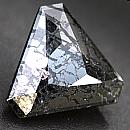|
|
|
|
 |
| Chromite |
|
|
Discovered in 1845; IMA status: Valid (pre-IMA; Grandfathered) | |||
|
|
|
Chemistry |
|
|
| |
|
Fe2+Cr2O4 | |
|
|
Iron Chromium Oxide |
|
Molecular Weight: |
223.84 gm |
|
Composition: |
Chromium |
46.46 % |
Cr |
67.90 % |
Cr2O3 |
|
|
Iron |
24.95 % |
Fe |
32.10 % |
FeO |
|
|
Oxygen |
28.59 % |
O |
|
|
|
|
|
100.00 % |
|
100.00 % |
= TOTAL OXIDE |
|
|
|
||||
|
Classification |
|
|
| |
|
Oxides | |
|
4/B.03-20 | |
|
|
4 : OXIDES (Hydroxides, V[5,6] vanadates, arsenites, antimonites, bismuthites, sulfites, selenites, tellurites, iodates)
|
|
Related to: |
Spinel Group. Dimorph of Xieite. Chromite-Hercynite Series. Chromite-Magnesiochromite Series. The iron analogue of Zincochromite, Cochromite, Manganochromite and Magnesiochromite. The chromium analogue of Hercynite, Coulsonite and Magnetite. |
|
Members of Group: |
Spinel Group: Chromite, Franklinite, Gahnite, Galaxite, Hercynite, Jacobsite, Magnesiochromite, Magnesioferrite, Magnetite, Qandilite, Spinel, Trevorite |
|
Varieties: |
Aluminian Chromite, Alumoberezovite, Berezovskite, Chromferrite, Chrompicotite, Ferrian Chromite, Magnochromite, Niccochromite, Phosphochromite, Titaniferous Chromite |
|
Synonyms: |
Autunite (of Leymerie), Beresofite (of Simpson), Chromate of Iron, Chromic Iron, Chromoferrite, Chrompicotite (of Lacroix), Eisenchrome, Ferrochromate, Ferrochromite, Irite, Siderochrome |
|
|
|
|
Crystal Data |
|
|
|
|
|
Crystals octahedral, modified by the cube or dodecahedron, to about 1 em; commonly fine granular, compact, massive. |
|
|
On {111} as both twin and composition plane, the Spinel law. |
|
|
|
|
|
Physical Properties |
|
|
|
|
|
Parting may develop along {111}. |
|
|
Irregular/Uneven |
|
|
Brittle |
|
|
5.5; VHN = 1278-1456 (100 g load) |
|
|
4.50 - 4.80 (g/cm3) |
|
|
None |
|
|
Not Radioactive |
|
|
Other: |
Some samples are weakly magnetic due to zones of Magnetite composition. |
|
|
|
|
Optical Properties |
|
|
|
|
|
Black to brownish black; brown to brownish black on thin edges in transmitted light; in reflected light, gray-white with a brownish tint and brownish red internal reflections. |
|
|
Translucent to Opaque |
|
|
Metallic to Submetallic |
|
|
2.080 - 2.160 Isotropic |
|
|
0.000 (Isotropic minerals have no birefringence) |
|
|
n/a |
|
|
None |
|
|
In
reflected light: gray-white with a brownish tint. |
|
|
|
|
|
Occurances |
|
|
|
|
|
Geological Setting: |
A cumulus mineral in ultramafic portions of layered mafic igneous rocks; an accessory mineral in alpine-type peridotites; also detrital. Common in all meteorites, except carbonaceous chondrites, and in lunar mare basalts. |
|
Common Associations: |
Olivine, Enstatite, Plagioclase, Serpentine, Magnetite, Ilmenite, Pyrrhotite, Pentlandite, Ulvospinel. |
|
Common Impurities: |
Mg, Mn, Zn, Al, Ti |
|
Type Locality: |
Bastide de la Carrade, Gassin, Var, Provence-Alpes-Côte d'Azur, France |
|
Year Discovered: |
1845 |
|
View mineral photos: | |
|
|
|
|
Unusual Gem Categories |
|
|
|
|
|
| |
|
|
|
|
More Information |
|
|
|
|
|
| |
|
|
|
|
Chromite is a member of the Spinel Group of minerals that also includes Franklinite, Gahnite, Magnesite and Spinel among others. Chromite is the most important ore of chromium (Cr) from which it derives its name. Chromium is an important metal that has a wide range of industrial uses. Chromite forms in deep ultra-mafic magmas and is one of the first minerals to crystallize. It is also found in metamorphic rocks such as Serpentines. Gems and specimens of the Serpentine variety Williamsite often contain inclusions of microcrystals of Chromite. Chromite has a Mohs hardness of 5.5 and a metallic luster making for very attractive faceted gems. Some Chromite specimens and gems may be weakly magnetic due to zones of Magnetite composition. Chromite was named in 1845 by Austrian mineralogist Wilhelm Karl Ritter von Haidinger (1795-1871) for its chromium content. The element chromium (Cr) was discovered and named in 1797 by French pharmacist and chemist Louis Nicolas Vauquelin (1763-1829) from the Greek word χρώμα (chrōma) meaning color, because many of its compounds are intensely colored. The mineral Vauquelinite was named in 1818 by Swedish chemist Jöns Jakob Berzelius (1779-1848) to honor Vauquelin. Although Chromite is cited as being discovered in France in 1845, the species was originally described and named chromian-säure eisen in 1798 by P. Meder from samples discovered on the banks of a small river in the northern Urals of Russia by Mr. Soymonof, then director of mines for the Northern part of the Urals. Chromite has been known by several names over time starting with the original name, chromian-säure eisen in 1798, then named Eisenchrom also in 1798, then named fer chromaté aluminé in 1800, then Chromeisenstein in 1832, then Siderochrome in 1841, then Chromoferrite in 1843 and finally its current name, Chromite, in 1845. Chromite distribution: widespread; from Gassin, Var, France. Large crystals from Hangha, Sierra Leone. At Tiebaghi, New Caledonia. As economic deposits in: the Bushveld complex, Transvaal, South Africa. From the Great Dyke, Zimbabwe. From many localities in Turkey. At Saranay and elsewhere in the Ural Mountains, Russia. From the Moa district, northern Cuba. On Luzon, Philippines. From the Stillwater complex, Stillwater County, Montana, USA. |
|
|
Chromite gems for sale: We have not photographed our Chromite gems yet. Please check back soon. |